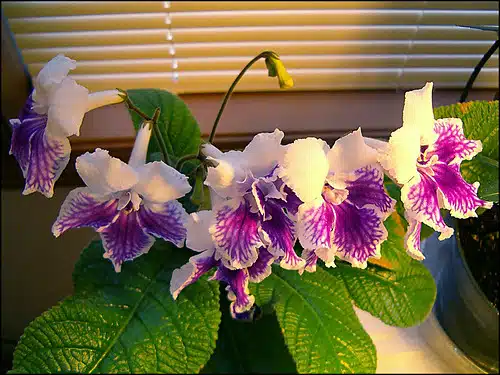Streptocarpus, commonly known as Cape Primrose, is a popular houseplant that adds a dash of color to any indoor space. With their delicately frilled flowers in shades of blue, purple, pink, and white, they are a favorite among horticultural enthusiasts. Growing Streptocarpus indoors is easy and rewarding, with minimal maintenance required.
In this article, we will explore the various aspects of growing Streptocarpus indoors. From choosing the right location to providing optimal lighting conditions and watering requirements, we will provide all the necessary information for beginners and experienced gardeners alike. Whether you’re looking to add a touch of natural beauty to your home or wanting to expand your collection of houseplants, growing Streptocarpus indoors is an excellent choice that will bring joy and satisfaction for years to come.
Origins And Characteristics Of Streptocarpus
Streptocarpus is a genus of flowering plants that belongs to the family Gesneriaceae. These plants are native to Africa, Madagascar, and other tropical regions. Streptocarpus was first discovered in the early 19th century by John Lindley, a British botanist. Today, there are over 150 species of Streptocarpus known to exist.
Streptocarpus has evolved over time through natural selection and human cultivation. The plants have become popular among gardeners and horticulturalists due to their unique characteristics. One interesting fact about these plants is their cultural significance in some African countries where they are used for medicinal purposes. Additionally, streptocarpus exhibits great genetic diversity which has led to the development of many hybrid varieties.
The history and evolution of streptocarpus reveal its fascinating origins and characteristics as a plant species. These features make it an attractive option for those interested in indoor gardening or horticulture. Understanding the cultural significance and genetic diversity of streptocarpus can help individuals appreciate its value even more as they explore the benefits of growing this plant indoors.
Benefits Of Growing Streptocarpus Indoors
Growing streptocarpus indoors requires careful consideration of its water and lighting needs. When it comes to water, streptocarpus should be watered when the soil is dry to the touch, but not so frequently that the soil becomes waterlogged. In terms of lighting, streptocarpus should be placed in bright, indirect sunlight or grow lights for optimal growth. Lastly, it is important to monitor the humidity level in the room where the streptocarpus is growing to ensure it is not too low.
Water Requirements
The success of growing streptocarpus indoors relies heavily on providing the plant with the right amount of water. Overwatering and underwatering can both lead to detrimental effects on the health of the plant, so it is important to understand its watering requirements.
Streptocarpus prefers to be kept evenly moist, but not wet or soggy. Watering frequency will depend on factors such as humidity levels, temperature, and potting soil used. In general, a good schedule is to water when the top inch of soil feels slightly dry to the touch. The frequency of watering may change throughout the year due to changes in seasonal conditions such as increased indoor heating during winter months.
It is recommended to use a watering method that allows for thorough soaking without leaving standing water in the pot. One effective method is bottom-watering, where the plant sits in a tray filled with water for 10-15 minutes until the soil has absorbed enough moisture. This ensures that all roots are uniformly hydrated and minimizes risk of overwatering by allowing excess water to be drained away. Proper watering techniques will promote healthy growth and vibrant blooms in your indoor streptocarpus plant.
Lighting Needs
As a horticulturalist or gardening expert, it is important to understand the benefits of growing streptocarpus indoors. Apart from its vibrant blooms, this plant can help purify indoor air and improve humidity levels. However, to ensure that the plant thrives indoors, gardeners must provide adequate lighting conditions.
Streptocarpus requires bright, indirect light for optimal growth and flowering. Insufficient light may result in weak stems and foliage, as well as reduced bloom production. Therefore, it is necessary to adjust the lighting conditions according to the plant’s needs. One way to achieve this is by placing streptocarpus near windows with filtered sunlight or using artificial light fixtures such as fluorescent lamps or LED grow lights.
When using artificial light fixtures, gardeners should take note of the intensity and duration of light exposure. Streptocarpus requires at least 12-16 hours of bright light per day during its active growing phase. It is also important to position the light source close enough to provide sufficient illumination without causing heat damage or burning of leaves. By understanding and meeting the lighting requirements of streptocarpus, gardeners can enjoy healthy plants with vibrant blooms all year round without worrying about seasonal changes affecting their growth.
In summary, proper lighting conditions play a crucial role in the success of growing streptocarpus indoors. Gardeners must be mindful of adjusting natural or artificial light sources according to the plant’s needs while avoiding overexposure or inadequate illumination. By providing optimal lighting conditions in addition to appropriate watering methods, gardeners can reap the many benefits that come with growing this beautiful indoor plant species.
Choosing The Right Container For Your Streptocarpus
When it comes to growing streptocarpus indoors, choosing the right container is crucial. The container should not only provide ample space for the plant’s root system but also be able to hold water and allow for proper drainage. Self-watering containers are an excellent option for those who tend to forget about watering their plants regularly. These containers come equipped with a reservoir that holds water, allowing the plant to absorb what it needs when it needs it.
Another consideration when selecting a container for your streptocarpus is its aesthetic appeal. Decorative pot options abound in today’s market, making it easy to find a container that complements your home decor while providing an ideal environment for your plant’s growth. When selecting a decorative pot, make sure that there are drainage holes at the bottom of the pot to prevent waterlogging.
Overall, choosing the right container for your streptocarpus involves finding a balance between function and form. A self-watering container can take care of your plant’s watering needs while still looking stylish in your home. On the other hand, a decorative pot can add visual interest while still providing adequate drainage and space for root growth. Next up: selecting the ideal soil mix to ensure optimal growth and health of your streptocarpus.
Selecting The Ideal Soil Mix
After selecting the appropriate container for your indoor Streptocarpus, it’s time to focus on creating the ideal soil mix. Your choice of potting mix will greatly affect the growth and overall health of your plant. There are several potting mix options available in gardening stores, each with their unique features and advantages.
One important factor to consider when choosing a potting mix is its pH level. A pH level between 5.5 and 6.5 is considered optimal for Streptocarpus growth. Therefore, it’s important to choose a potting mix that has been formulated with this range in mind. Alternatively, you can make your own soil mix by combining peat moss or coconut coir, perlite, vermiculite, and composted bark.
Another consideration when selecting a potting mix is its ability to retain moisture while also providing adequate drainage. A well-draining soil mix prevents waterlogging, which can lead to root rot and other fungal diseases. On the other hand, a soil mix that doesn’t retain enough moisture can result in stunted growth or even death of the plant due to dehydration. Finding the right balance between moisture retention and drainage is crucial for optimal Streptocarpus growth.
Moving forward, ensuring proper watering and humidity requirements will be essential in maintaining healthy Streptocarpus growth indoors.
Watering And Humidity Requirements
One of the most important factors in growing streptocarpus indoors is consistent watering. These plants require a consistent level of moisture, but not too much or too little. Overwatering can lead to root rot and fungal diseases, while underwatering can cause wilting and stunted growth. To ensure proper watering consistency, always check the top inch of soil before watering. If it feels dry to the touch, it’s time to add water.
In addition to proper watering, humidity levels should also be monitored for optimal growth. Streptocarpus thrive in a humid environment and are sensitive to changes in humidity levels. One way to measure humidity is by using a hygrometer or a digital thermometer with a built-in hygrometer. Keep the humidity level between 50-60% by misting the leaves regularly or placing a tray of water near the plant.
Maintaining consistent watering and humidity levels will not only keep your streptocarpus healthy but also promote better blooming and foliage growth. However, it’s important to note that every plant has its own unique preferences when it comes to watering and humidity requirements. It’s essential to observe your plant’s behavior closely and adjust accordingly if you notice any signs of stress such as yellowing leaves or wilting.
As we have seen, watering consistency and proper humidity levels are crucial factors in growing successful streptocarpus indoors. The next section will cover another essential aspect of indoor gardening: optimal lighting conditions for these plants. By following these simple tips, you can help your plant thrive and enjoy its beautiful blooms year-round.
Optimal Lighting Conditions
Watering and humidity are crucial factors in successfully growing streptocarpus indoors, but lighting conditions also play a significant role. Adequate light is essential for photosynthesis to occur, which is necessary for the plant’s growth and development. Insufficient lighting can result in stunted growth, pale leaves, and fewer flowers.
When it comes to optimal lighting conditions for streptocarpus plants, it is important to consider both the light spectrum and duration. The light spectrum refers to the range of wavelengths that make up the light source. Plants require different wavelengths of light at different stages of their growth cycle. Blue light promotes vegetative growth while red light encourages flowering. Therefore, using a full-spectrum grow light that provides both blue and red lights can be beneficial for overall plant health.
The duration of exposure to light is equally important as the spectrum of light. Streptocarpus plants thrive with 12-16 hours of bright, indirect sunlight or artificial grow lights per day. However, exposing them to more than 16 hours of continuous light can lead to plant stress and damage. On the other hand, inadequate lighting can hinder blooming and overall plant development. It is essential to maintain a consistent daily photoperiod by providing bright but not direct sunlight or using an artificial grow light with a timer system.
As we have seen, proper lighting conditions are critical for indoor streptocarpus cultivation success. To further optimize their environment, temperature and airflow considerations must also be taken into account.
Temperature And Airflow Considerations
Like a cool breeze on a hot summer day, proper airflow and temperature control are essential for the optimal growth of streptocarpus. It is pivotal to maintain a steady temperature range of 65-75°F during the day and 60-65°F at night. Fluctuating temperatures can cause stress and stunted growth in your plant, ultimately leading to its demise. In addition to regulating temperature, air filtration and ventilation control are also crucial factors to consider.
Air filtration aids in removing harmful pollutants from the air that can negatively impact the health of your streptocarpus. Investing in an air purifier or using natural methods, such as charcoal or activated carbon, can help eliminate toxins from your plant’s environment. Furthermore, proper ventilation allows fresh airflow into your space while removing stagnant air that may harbor fungal spores or other pathogens harmful to your plant.
In conclusion, maintaining an ideal temperature range combined with adequate air filtration and ventilation control is imperative for the optimal growth of streptocarpus indoors. Neglecting these elements can lead to poor plant health, stunted growth, and even death. In our next section, we will discuss fertilizing tips to help nourish your streptocarpus for robust growth and vibrant blooms.
Fertilizing Your Streptocarpus
Fertilizing your streptocarpus is crucial to ensure healthy growth and abundant flowering. There are two types of fertilizers available: organic and chemical. Organic fertilizers are made from natural sources such as compost, manure, or bone meal. On the other hand, chemical fertilizers are manufactured with a combination of nitrogen, phosphorus, and potassium.
Organic fertilizers provide a slow-release of nutrients to your streptocarpus over time. They improve soil structure and promote the growth of beneficial microorganisms in the soil. Chemical fertilizers are more commonly used in indoor gardening due to their ease of use and quick results. However, they can also cause salt build-up in the soil over time if not used correctly.
When choosing which type of fertilizer to use for your streptocarpus, it is important to consider the specific needs of the plant. Organic fertilizers may be more suitable for those who want a long-term approach to improving soil health and overall plant growth. Meanwhile, chemical fertilizers can provide an immediate boost in nutrients but should be used sparingly.
In order to maximize your success with your streptocarpus, it is important to understand how different types of fertilizers affect its growth. By choosing the right fertilizer and following proper application techniques, you can help your plant thrive. In the next section, we will discuss pruning and deadheading techniques that will help keep your streptocarpus looking beautiful year-round.
Pruning And Deadheading Techniques
Pruning and deadheading are important maintenance practices for keeping Streptocarpus plants healthy and attractive indoors. Pruning involves removing dead, damaged, or overgrown plant parts and is best done when the plant is actively growing. Deadheading involves removing spent flowers, and can be done any time throughout the growing season. Fertilizing, potting, and replanting should also be done regularly in order to maintain a healthy plant. Watering and humidity control should take place regularly, as should lighting and sun exposure. Air circulation is also necessary to keep the plant healthy, and specific pruning and deadheading tools should be used as well as specific pruning and deadheading schedules.
Pruning
Pruning is a crucial aspect of growing streptocarpus indoors, and it offers numerous benefits. By cutting back overgrown plants, you can promote the growth of new shoots and leaves. Pruning also helps to maintain the shape and size of your plant, preventing it from becoming too large or lopsided. Additionally, removing dead or diseased leaves through pruning can help to prevent the spread of diseases and pests.
When pruning your streptocarpus, it’s important to use sharp, clean shears or scissors that won’t damage the plant. Begin by cutting away any yellowed or damaged leaves at their base near the stem. You can also pinch back the tips of stems to encourage branching and fuller growth. Removing spent flower blooms through deadheading will also help keep your plant looking neat and tidy.
In conclusion, pruning is a critical part of maintaining healthy streptocarpus plants indoors. By using proper techniques for deadheading and removing damaged foliage, you can promote new growth while maintaining the overall shape and health of your plants. With regular pruning as part of your horticultural routine, you’ll be rewarded with beautiful, thriving plants that will bring joy to any indoor space!
Deadheading
Proper pruning and deadheading techniques are essential for maintaining healthy and vibrant streptocarpus plants indoors. Deadheading is the process of removing spent flower blooms, which offers numerous benefits. Firstly, it helps to promote new growth by directing the plant’s energy towards producing more flowers. Secondly, deadheading helps to keep your plant looking neat and tidy, enhancing its aesthetic appeal. Lastly, it prevents the formation of seed pods that can drain the plant of valuable nutrients.
To deadhead your streptocarpus properly, wait until the bloom has wilted and faded in color before removing it from the stem using clean shears or scissors. Cut as close to the stem as possible without damaging it, being careful not to remove any developing buds or leaves nearby. Deadheading should be done regularly throughout the growing season to ensure continuous blooming.
In conclusion, deadheading is an important component of proper pruning techniques that can help maintain a healthy and visually appealing indoor garden. With proper technique and regular maintenance, your streptocarpus plants will reward you with beautiful, vibrant blooms that will bring joy to any indoor space!
Plant Maintenance
Proper pruning and deadheading techniques are not the only aspects of maintaining a healthy and aesthetically pleasing indoor garden. Plant maintenance is equally important, as it involves caring for your plants’ overall health and wellbeing. One essential aspect of plant maintenance is repotting frequency. Streptocarpus plants require repotting every one to two years, depending on their growth rate and size. This allows them to continue thriving by providing fresh soil, nutrients, and adequate space for root development.
Pest prevention is another critical aspect of plant maintenance that should not be overlooked. Indoor plants are susceptible to a range of pests such as spider mites, mealybugs, and scale insects that can quickly spread if left unchecked. Prevention is key when it comes to pest control; inspecting new plants before bringing them indoors, regularly cleaning leaves with a damp cloth, and maintaining proper humidity levels can all help prevent infestations. If pests do appear, take prompt action by using natural or chemical remedies that will effectively rid the plant of pests without harming it.
Overall, pruning and deadheading are vital components of indoor gardening that should be done regularly to maintain healthy and beautiful streptocarpus plants. However, plant maintenance goes beyond these simple tasks; repotting frequency and pest prevention are also crucial aspects that must be considered to ensure your plants thrive in their indoor environment. By incorporating these practices into your routine care regimen, you will enjoy vibrant blooms year-round while also promoting a healthy ecosystem for your beloved houseplants!
Propagation Methods For Streptocarpus
One interesting statistic about Streptocarpus is that they are capable of producing more than 100 flowers on a single stem. This makes them a popular choice for indoor gardening enthusiasts who want to bring a burst of color into their homes. As such, propagation methods for Streptocarpus have become essential knowledge for anyone looking to grow these plants indoors.
Water propagation is one method that has gained popularity in recent years. It involves taking stem cuttings from the plant and placing them in water until roots begin to form. Once the roots are established, the cutting can be transferred to soil, where it will continue to grow into a new plant. This method is particularly useful because it allows gardeners to propagate multiple plants from a single mother plant.
Another effective propagation technique is division. This involves separating the mother plant into smaller sections, each with its own root system and foliage. Once separated, each section can be transplanted into its own pot or container and grown individually. Division techniques are particularly useful for those who want to create multiple plants quickly or who want to rejuvenate an older plant by removing dead or diseased portions.
As we have seen, there are several effective propagation methods that can be used when growing Streptocarpus indoors, including water propagation and division techniques. However, it is important to note that these methods may not always produce identical copies of the mother plant due to genetic variation. In addition, gardeners must also be aware of common pests and diseases that can affect their Streptocarpus plants if they wish to maintain healthy growth over time.
Common Pests And Diseases To Watch Out For
After successfully propagating your streptocarpus, it’s time to focus on growing them indoors. Streptocarpus requires a humid and warm environment, so ensure that you place them in a spot with indirect sunlight and keep the soil moist. You can also use a humidifier to maintain the required level of humidity.
However, just like any other plant, streptocarpus is prone to pests and diseases. Preventing infestation is crucial, so regularly check the leaves for any signs of insects such as spider mites or aphids. If you notice any pests, use an insecticidal soap or neem oil to control them. Additionally, fungal infections are common in streptocarpus due to their need for moisture. To prevent this, avoid overwatering and improve air circulation around the plant.
To ensure your streptocarpus thrives indoors, here are some tips:
- Use well-draining soil mix with added perlite or sand for better drainage.
- Fertilize every two weeks during the growing season with a balanced fertilizer.
- Deadhead spent blooms regularly to promote more blooming.
- Repot every two years into a slightly larger container with fresh potting mix.
- Rotate the plant periodically to allow all sides access to light.
By following these tips and preventing infestations while treating fungal infections promptly if they occur, your indoor streptocarpus will continue to flourish. However, if you encounter any issues beyond pests and diseases, troubleshooting common issues will be necessary.
Troubleshooting Common Issues
Did you know that even the most experienced gardeners encounter problems when growing streptocarpus indoors? In fact, it is estimated that 70% of indoor streptocarpus growers will experience some form of issue with their plants. However, with an understanding of common issues and how to troubleshoot them, you can ensure a healthy and beautiful display.
Diagnosing pests is one of the most common issues that indoor streptocarpus growers face. Pests such as spider mites, mealybugs, and aphids can quickly take over your plants if not detected and treated promptly. Look for signs such as wilting leaves, yellowing foliage, or sticky residue on the leaves. If you suspect pests are present, isolate the plant immediately and treat it with an appropriate pesticide. Be sure to follow application instructions carefully to avoid damaging your plant.
Troubleshooting watering issues is another common problem faced by indoor streptocarpus growers. Overwatering can lead to root rot, while under-watering can cause dryness and wilting in your plant. To determine if your plant needs water, stick your finger about an inch into the soil – if it feels dry, it’s time to water. If you notice standing water in the pot’s saucer or drainage holes, remove excess water immediately to prevent root rot. Remember that proper watering is crucial for a healthy and thriving streptocarpus display.
| Problem | Signs | Solution |
|---|---|---|
| Spider Mites | Webbing on plants; stippling on leaves; visible mites | Isolate plant; apply insecticidal soap or neem oil |
| Root Rot | Wilting; yellowing foliage; soft brown roots | Remove affected roots; repot in fresh soil |
| Under-watering | Dry soil; wilted leaves | Water thoroughly; increase frequency of watering |
Incorporating these tips into your indoor streptocarpus growing routine can help you avoid common issues and promote a healthy display. However, for more advanced growing techniques, stay tuned for our section on tips for experienced gardeners.
Advanced Growing Techniques For Experienced Gardeners
Indoor gardening is a fantastic way to keep plants thriving all year round, and with unique varieties of streptocarpus available, there are endless possibilities for experienced gardeners looking to take their skills to the next level. To ensure that your streptocarpus is healthy and flourishing, it is essential to adopt advanced growing techniques that will allow your plant to thrive.
One of the most effective ways of ensuring your streptocarpus remains healthy and vibrant is by using an appropriate potting mix. A well-draining soil mix combined with organic material such as peat moss or perlite will provide sufficient nutrients while also allowing air circulation around the roots. This technique ensures that the soil never becomes too compacted or waterlogged, which can lead to root rot.
Another advanced technique in growing streptocarpus is by controlling light exposure. Streptocarpus requires moderate levels of light exposure but direct sunlight can damage its leaves. Using shade cloth or sheer curtains can help regulate light intensity and prevent leaf scorching. Controlled lighting also allows you to manipulate flowering times, which can be beneficial if you want your plant blooming at specific times of the year.
Incorporating these advanced growing techniques into your indoor gardening routine will undoubtedly improve the health and longevity of your streptocarpus. With proper care, you’ll have beautiful and vibrant blooms all year round, adding a touch of nature’s beauty in your home space.
*Don’t limit yourself- Experiment with different varieties *Be patient- Streptocarpus growth takes time *Spend quality time with your plants- Gardening has therapeutic value
Now that you have learned some advanced techniques for growing your streptocarpus indoors, it’s time to think about how best to display them in your home space.
Displaying Your Streptocarpus
Creative displays are a great way to showcase your growing collection of streptocarpus. Whether you are growing them in pots, hanging baskets or terrariums, there are endless possibilities for displaying these beautiful plants. A popular trend is to group together different varieties with complementary colors and textures to create a visually appealing arrangement.
Seasonal arrangements can also add an extra element of interest to your streptocarpus display. For example, in the winter months, you could add some festive decorations such as small ornaments or fairy lights to your planters. In the summer months, you could incorporate some outdoor elements such as seashells or driftwood into your displays. These seasonal touches can transform your indoor garden into a work of art.
When it comes to displaying your streptocarpus, the key is to get creative and experiment with different arrangements. Don’t be afraid to mix and match different planters, pots and baskets until you find the perfect combination that showcases your plants in the best possible light. With a little bit of creativity and imagination, you can enjoy the beauty of these stunning plants year-round.
Transition: Now that we have covered all aspects of growing and displaying streptocarpus indoors, let’s move on to how we can enjoy their beauty throughout the year without any hassle or stress.
Conclusion: Enjoying The Beauty Of Streptocarpus Year-Round
Decorating your home with streptocarpus is an excellent way to add beauty and color to indoor spaces year-round. With a little bit of maintenance, these plants can thrive in various lighting conditions, making them perfect for any room in your home. Whether you prefer a more minimalist approach or love to fill every nook and cranny with greenery, there are plenty of decorating tips to help you showcase your streptocarpus.
One way to display your streptocarpus is by grouping multiple plants together on a shelf or table. This creates a visually appealing arrangement that draws the eye and can be easily customized to suit your decor style. Alternatively, you can place individual plants in decorative pots and scatter them throughout your home for a pop of color wherever you need it most.
To keep your streptocarpus healthy and looking their best, it’s important to follow proper maintenance techniques. These include watering regularly but not overwatering, providing adequate light without exposing them to direct sunlight, and fertilizing every 4-6 weeks during the growing season. By taking good care of your plants, they will reward you with vibrant blooms year after year.
Overall, incorporating streptocarpus into your home decor is an excellent way to bring the beauty of nature indoors all year long. Whether you’re new to gardening or an experienced horticulturalist, these versatile plants offer something for everyone. So why not brighten up your living space today with a few carefully placed streptocarpus?
Conclusion
Streptocarpus is a beautiful and easy-to-grow plant that originated in Africa. With its lovely foliage and delicate flowers, it has become a popular choice for indoor gardeners looking to add some color and life to their homes. By following a few simple guidelines on container selection, soil mix, watering, and humidity, even novice gardeners can successfully grow streptocarpus indoors.
When selecting a container for your streptocarpus, be sure to choose one that provides adequate drainage and allows room for growth. A well-draining soil mix that is rich in organic matter is essential for proper growth and development of the plant. Watering should be done carefully to avoid over-watering or under-watering, while maintaining proper humidity levels. Common issues such as leaf yellowing or wilting can be easily addressed by adjusting these factors.
For experienced gardeners looking to take their streptocarpus growing to the next level, advanced techniques such as propagation or hybridization can be explored. Whether grown individually or in groups, displaying your streptocarpus can add beauty and interest to any space.
As the adage goes, “The love of gardening is a seed once sown that never dies.” Growing streptocarpus indoors provides an opportunity for gardeners of all skill levels to cultivate this love year-round. By following best practices for container selection, soil mix, watering and humidity management, troubleshooting common issues and exploring advanced growing techniques when appropriate, you too can enjoy the beauty of streptocarpus in your home.
Image Credits
- “Streptocarpus: Bristol’s Tie Dyed–2009_11_11” by John A. Robinson (featured)





























